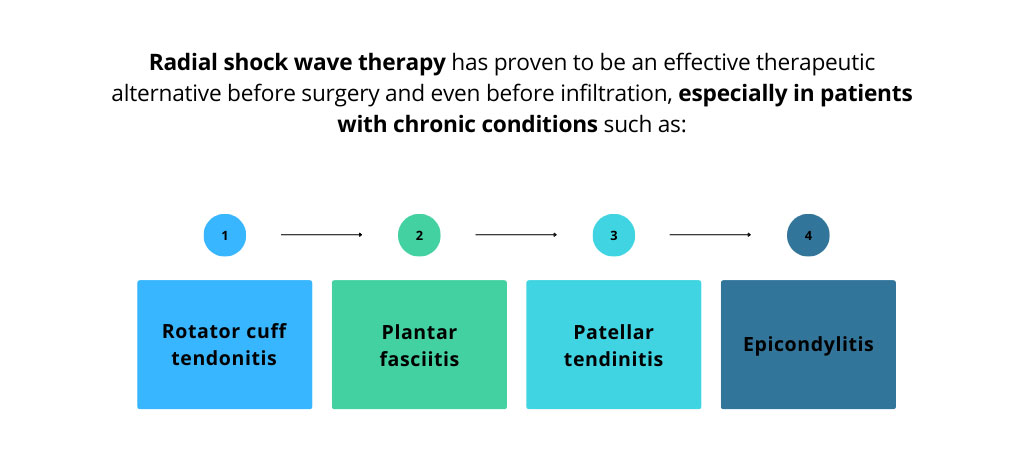Used in chronic pain conditions
Introduced in the early 80s, Shockwave therapy was initially used to dispose of a non-evasive renal calculi (kidney stones). Since the early 2000s, several studies have demonstrated the effectiveness of this modality in the treatment of several chronic musculoskeletal conditions.
Shockwave therapy is used in conditions of chronic pain among others to promote vascularization of the affected tissues, to reduce the adhesion level of the collagen, in addition to allowing an analgesia against irritation. Shockave therapy also has physiological effect of increased activity and cell permeability, thus promoting better healing.

Its effectiveness has been demonstrated particularly with calcific tendonitis of the rotator cuff. For this pathology, Shockwave therapy is now considered the first line of treatment. It has been shown to significantly decrease calcium deposit located at the tendon and promoting a return to normal shoulder function and a significant reduction of pain in patients with this disease. Shockwave theraoy must be administered 3 to 6 times with an interval of 5-10 days between each intervention for optimal healing.
For more information on this subject please do not hesitate to consult a physiotherapist of our team.
Reference
- Carcia and Scibek. Management of calcific tendonitis and periarthritis. Lippincott Williams & Wilkins. March 2013 Volume 25 Number 2.
- Brett M. et al. Treatment of tendinopathy. Clin Orthop Relat Res. (2008) 466:1539-1554
- Gosens and Hofstee. Calcifying tendinitis of the shoulder: advances in imaging and management. Curr Rheum reports 2009; 11:129-134.
- Cacchio, Paolini, Barile et al. Effectiveness of radial shock-wave therapy for calcific tendonitis of the shoulder: single-blind, randomized clinical study. Phys Ther 2006; 86:672-682.
- Farr, Sevelda, Mader, et al. Extracorporeal shockwave therapy in calcifying tendinitis of the shoulder. Knee Surg Sports Traumatol Athrosc 2011; 19:2085-2089.
AVAILABLE AT OUR FOLLOWING CLINICS
OFFERED BY THE FOLLOWING PHYSIOTHERAPISTS
- Abygaël Martin
- Adèle Pichette-Auray
- Alexandra Champagne
- Alexandre Grenier
- Alyssia Mino-Roy
- Amélie Boucher
- Antoine Laramée
- Camille Choinière
- Carolanne Gariépy
- Catherine Apinis
- Catherine Bibeau
- Christophe Lachance
- Clovis Beauchemin
- Dérick Laforest
- Désirée Brauchi
- Élizabeth Cloutier
- Élizabeth Duclos-Beaudoin
- Élizabeth Dumas-Longpré
- Élizabeth Parenteau-Goudreault
- Émilie Lambert-Cyr
- Éric Bouchard
- Eulalie Martel
- Florence Lafleur-Gagnon
- François Auray
- Frédérique Jacques
- Gaël Bernard-Perron
- Geneviève Bouchard-Landry
- Geneviève Langevin
- Geneviève Rémy Desrosiers
- Guillaume Léonard
- Guillaume Pitre
- Guylaine Langlois
- Jessica Lambert
- Joé Des Ruisseaux-Langlois
- Josef Pichette-Lefebvre
- Joseph-Étienne Bérubé
- Judith Paquin-Veillette
- Justine Boucher
- Kassandra Gamache
- Laurence Laprise
- Laurence Théorêt
- Laurianne Roberge
- Linda Gauvreau
- Louis-Simon Allaire
- Lucas Coulombe
- Lucie Guillemette
- Marguerite Brodeur
- Marie-Ève Allain
- Marie-Ève Laquerre
- Marie-Pier Gagnon
- Mathieu Juteau
- Megan Casoli
- Nicolas Boudreau
- Nicolas Cazzaro
- Nicolas Ducharme
- Pierre-Luc Lachance
- Sandrine Leblanc
- Sarah Carrier
- Simon Bisson-Petit
- Simon Charest-Hallée
- Sophie Houle
- Stéphanie Trépanier
- Virginie Adam


